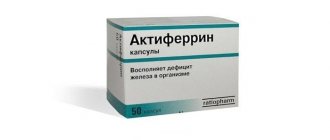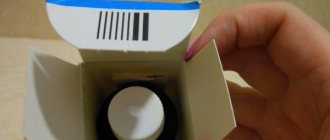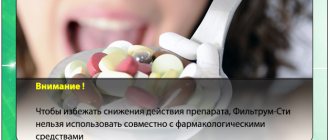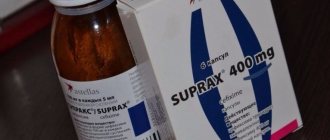Indications for use
The use of Cortef is indicated:
- Endocrinology: subacute thyroiditis, hypercalcemia due to malignant neoplasms, congenital adrenal hyperplasia, adrenal insufficiency (with replacement therapy as the drug of choice): primary (Addison's disease) - often in combination with mineralocorticoids, secondary - usually without mineralocorticoids;
- Dermatology: bullous dermatitis herpetiformis, pemphigus, exfoliative dermatitis, severe erythema multiforme (Stevens-Johnson syndrome), mycosis fungoides (Aliber's disease), severe seborrheic dermatitis, severe psoriasis;
- Rheumatology: additional short-term therapy during exacerbation or acute attack: rheumatoid arthritis (including juvenile rheumatoid arthritis), psoriatic arthritis, ankylosing spondylitis, bursitis (acute and subacute), acute gouty arthritis, acute nonspecific tenosynovitis, post-traumatic osteoarthritis, epicondylitis, synovitis in osteoarthritis ; maintenance therapy: acute rheumatic carditis, systemic dermatomyositis (polymyositis), systemic lupus erythematosus;
- Allergology: for the control of severe or disabling conditions, in the absence of an adequate effect of appropriate drugs: serum sickness, contact dermatitis, year-round or seasonal allergic rhinitis, bronchial asthma, atopic dermatitis, hypersensitivity reactions to drugs;
- Pulmonology: Loeffler's syndrome (in the absence of clinical effect when treated with other drugs), symptomatic sarcoidosis, berylliosis, aspiration pneumonia, disseminated or fulminant pulmonary tuberculosis in combination with anti-tuberculosis chemotherapy;
- Ophthalmology: chronic and severe acute diseases of allergic and inflammatory origin: eye lesions with Herpes zoster, keratitis, allergic conjunctivitis, iritis and iridocyclitis, allergic corneal ulcers, chorioretinitis, diffuse posterior choroiditis and uveitis, inflammatory pathologies of the anterior segment of the eye, sympathetic ophthalmia, ocular neuritis nerve;
- Oncology: palliative therapy: acute leukemia in children, leukemia and lymphomas in adults;
- Hematology: secondary thrombocytopenia in adults, idiopathic thrombocytopenic purpura in adults, congenital (erythroid) hypoplastic anemia, autoimmune (acquired) hemolytic anemia, erythrocyte anemia (erythroblastopenia);
- Neurology: exacerbation of multiple sclerosis;
- Nephrology: nephrotic syndrome without uremia, idiopathic type or against the background of systemic lupus erythematosus - stimulation of diuresis or remission of proteinuria;
- Other: tuberculous meningitis in the presence or threat of subarachnoid block (in combination with anti-tuberculosis chemotherapy).
Cortef tablets 10 mg No. 100
Glucocorticoid drug. It has anti-inflammatory, anti-allergic, anti-shock, immunosuppressive effects. It has mineralocorticoid activity and promotes sodium and water retention. Has a catabolic effect. Increases blood glucose levels, causes redistribution of adipose tissue, and promotes the removal of calcium from the body.
Pharmacokinetics of Cortef
Plasma protein binding – 40-90%. Metabolized primarily in the liver.
Indications Cortef
-endocrine diseases: primary and secondary adrenal insufficiency, congenital adrenal hyperplasia; -rheumatic diseases (in the form of a short course of additional therapy during an exacerbation): psoriatic arthritis, rheumatoid arthritis (in some cases and in the form of maintenance therapy in small doses), ankylosing spondylitis , acute and subacute bursitis, acute nonspecific tenosynovitis, acute gouty arthritis, osteoarthritis, synovitis, epicondylitis; - collagen diseases: systemic lupus erythematosus, systemic dermatomyositis (polymyositis), rheumatic carditis (including during exacerbation or in the form of maintenance therapy in some cases); - skin diseases: pemphigus, bullous dermatitis herpetiformis, severe erythema multiforme (Stevens-Johnson syndrome), exfoliative dermatitis, mycosis fungoides (Aliber's disease), severe psoriasis, severe seborrheic dermatitis; - allergic conditions (in severe or disabling conditions, not amenable to adequate treatment with appropriate drugs): seasonal or year-round allergic rhinitis, serum sickness, bronchial asthma, contact dermatitis, atopic dermatitis, hypersensitivity reactions to drugs; - eye diseases (severe acute and chronic allergic and inflammatory processes): allergic conjunctivitis, keratitis , allergic corneal ulcers, herpetic eye disease, iritis and iridocyclitis, chorioretinitis, inflammation of the anterior chamber of the eye, diffuse posterior uveitis and choroiditis, optic neuritis, sympathetic ophthalmia; - lung diseases: symptomatic sarcoidosis, Loeffler's syndrome (not treatable by other means), berylliosis, fulminant or disseminated pulmonary tuberculosis (in combination with anti-tuberculosis chemotherapy), aspiration pneumonia; - hematological diseases: idiopathic thrombocytopenic purpura (in adults), secondary thrombocytopenia (in adults), autoimmune hemolytic anemia, erythrocyte anemia, congenital hypoplastic anemia; - palliative therapy of leukemia and lymphomas in adults, acute leukemia in children; - hypercalcemia in malignant neoplasms; - nephrotic syndrome (in the absence of severe renal failure) - to increase diuresis or reduce proteinuria; - gastrointestinal diseases: ulcerative colitis, local enteritis (as part of complex therapy ); - multiple sclerosis (in the acute phase); - tuberculous meningitis with subarachnoid blockade (or its threat) when used in combination with specific anti-tuberculosis chemotherapy;
- trichinosis with damage to the nervous system or myocardium.
Dosage regimen Cortef
Set individually, depending on the indications, the effectiveness of therapy and the patient’s condition. The initial dose can vary from 20 mg to 240 mg per day.
The maintenance dose is determined by gradually reducing the initial dose until the lowest dose that maintains the desired effect is reached. After long-term use, discontinuation of the drug is carried out gradually.
For exacerbation of multiple sclerosis, the drug is prescribed at a dose of 800 mg/day for a week, and then 320 mg/day for a month.
Side effects of Cortef
From the side of the central nervous system: increased intracranial pressure with the development of papilledema, convulsions, dizziness, headache. From the organ of vision: posterior subcapsular cataract, increased intraocular pressure, glaucoma, exophthalmos.
https://www.youtube.com/watch?v=hVjzGQnizIk
From the endocrine system: Cushingoid syndrome, growth suppression in children, secondary adrenal and hypothalamic-pituitary unresponsiveness (especially during stress, illness, surgery or injury), menstrual irregularities, decreased tolerance to carbohydrates, manifestation of latent diabetes mellitus, increased need in insulin or oral hypoglycemic agents in patients with diabetes mellitus. From the musculoskeletal system: muscle weakness, steroid myopathy, loss of muscle mass, osteoporosis, vertebral compression fractures, aseptic necrosis of the heads of the femur and humerus, pathological fractures of long bones. From the side digestive system: steroid ulcer with possible perforation and bleeding, flatulence, ulcerative esophagitis, increased activity of liver transaminases and alkaline phosphatase (usually asymptomatic and reversible), pancreatitis. From the side of water-electrolyte balance: sodium retention, fluid retention, hypokalemic alkalosis, increase excretion of potassium and calcium. From the metabolic side: negative nitrogen balance due to increased protein catabolism.
Dermatological reactions: disruption of wound healing processes, thinning and fragility of the skin, petechiae and ecchymosis, facial erythema, increased sweating.
Contraindications Cortef
- systemic fungal infections; - increased sensitivity to the drug.
Pregnancy and lactation Cortef
The use of the drug during pregnancy and lactation requires a careful assessment of the ratio of the expected benefit to the mother and the potential risk to the fetus and child. Children born to mothers who received significant doses of the drug during pregnancy should be carefully examined to identify possible signs of adrenal dysfunction.
Special instructions Cortef
Cortef should be prescribed with caution to patients with ulcerative colitis due to the risk of developing perforation, abscess or other purulent infections; patients with diverticulitis, fresh intestinal anastomoses, erosive and ulcerative lesions of the gastrointestinal tract; severe renal dysfunction; arterial hypertension, osteoporosis, myasthenia gravis.
For herpetic eye infections, Cortef is used with caution due to the high risk of corneal perforation. It should be taken into account that in patients with hypothyroidism or liver cirrhosis, the effect of GCS may vary.
When using Cortef, there may be an increase in existing emotional instability or psychotic manifestations in patients, as well as the manifestation of mental disorders ranging from euphoria, insomnia, mood instability, personality changes and depression to severe psychotic manifestations. It should be borne in mind that when changing the dose, constant monitoring is necessary .
During the use of GCS, some symptoms of existing infectious diseases may be masked and new infections may develop, incl. secondary fungal and viral eye infections.
When Cortef is used in medium and high doses, an increase in blood pressure, salt and water retention, and increased potassium excretion are possible; therefore, it is necessary to limit salt intake from food and prescribe potassium supplements.
While using Cortef (especially in high doses), patients should not be vaccinated due to the potential risk of neurological complications and insufficient antibody production. The use of Cortef for active tuberculosis should be limited to cases of fulminant or disseminated tuberculosis in combination with mandatory anti-tuberculosis chemotherapy.
If it is necessary to prescribe Cortef to patients with latent tuberculosis or with increased reactivity to tuberculin, careful medical monitoring should be carried out to monitor the patient's condition and the course of the tuberculosis process, since reactivation of the disease is possible. During long-term therapy, these patients should receive chemoprophylaxis.
https://www.youtube.com/watch?v=Le1t2d-u2_0
Secondary adrenal insufficiency caused by the administration of Cortef can be minimized by gradually reducing the dose. It should be borne in mind that adrenal insufficiency may continue for several months after the end of treatment; therefore, in any stressful situations during this period, GCS should be re-prescribed.
With the use of Cortef, susceptibility to infections increases, and the course of the disease can be much more severe. It is necessary to exclude contacts of non-immunized or non-ill patients with sick people. In case of infection with chickenpox, prophylactic administration of immunoglobulin for serotherapy of chickenpox may be indicated, and in case of infection with measles, intramuscular administration of anti-measles immunoglobulin. With the development of chickenpox, antiviral drugs should be prescribed. In patients with hypoprothrombinemia, acetylsalicylic acid should be prescribed with caution in combination with Cortef. Use in pediatrics
With long-term use of Cortef in newborns and young children
Their growth and development should be carefully monitored.
Overdose of Cortef
Clinical symptoms of acute overdose of Cortef have not been described. The drug is eliminated by dialysis.
Drug interactions Cortef
Pharmacokinetic interaction: When Cortef is used simultaneously with inducers of microsomal liver enzymes (phenobarbital, phenytoin, rifampin), the clearance of hydrocortisone may increase (which may require an increase in the dose of Cortef).
When used in combination with Cortef, troleandomycin and ketoconazole may suppress the metabolism of hydrocortisone and reduce its clearance (which may require a reduction in the dose of Cortef).
With simultaneous use, Cortef may increase the clearance of acetylsalicylic acid with long-term use in high doses (this may lead to a decrease in plasma concentrations of salicylate and significantly increase the risk of salicylate toxicity when Cortef is discontinued).
When Cortef is used in combination with indirect anticoagulants, the therapeutic effectiveness of the latter may decrease.
Storage conditions for Cortef
The drug should be stored at room temperature (from 15° to 30°C). Conditions for dispensing from pharmacies
The drug is available with a prescription.
You can buy Cortef at the online pharmacy 9800000.ru with home delivery. The quality of all products in our online pharmacy, including Cortef, undergo product quality control by our trusted suppliers. You can buy Cortef on our website by clicking on the “Buy” button. We will be happy to deliver Cortef to you completely free of charge to any address within our delivery area.
Source: https://9800000.ru/products/item2274.html
Contraindications
- Systemic fungal infections;
- Indication in the anamnesis of hypersensitivity to the components of the drug.
Cortef should be prescribed with extreme caution in cases of confirmed or suspected strongyloidiasis.
In addition, caution should be exercised when prescribing the drug to patients with hypertension, diverticulitis, ulcerative colitis, fresh intestinal anastomoses, latent or active peptic ulcers, osteoporosis, renal failure, myasthenia gravis.
Prescribing the drug to women of childbearing age, during pregnancy or breastfeeding requires an assessment of the expected positive effect for the mother and the potential risk of the therapy for the fetus or child.
Pregnancy and lactation
Since studies of the effect of GCS on human reproductive function have not yet been conducted, the use of the drug during pregnancy, lactation (breastfeeding) or in women of childbearing age requires an assessment of the likely positive effect and potential risk of the therapy for the mother, embryo or fetus.
Children whose mothers received significant doses of corticosteroids during pregnancy should be carefully examined to identify possible symptoms of adrenal insufficiency.
Directions for use and dosage
Cortef tablets are taken orally.
The dosage regimen is prescribed by the attending physician based on clinical indications and severity of the disease.
The initial dose is from 20 mg to 240 mg per day; to achieve a therapeutic effect during treatment, individual dose adjustment is possible. After achieving an adequate response, a maintenance dose is established, gradually reducing it to the lowest effective dose (during this period the patient requires careful medical supervision).
Dose adjustment should be carried out in case of changes in the clinical picture (remission or exacerbation of the disease), or individual hypersensitivity. During periods of stressful situations not related to the initial disease, the dose of the drug must be increased.
If there is no clinical effect after long-term use of Cortef, the drug should be discontinued. Discontinuation of the drug after long-term therapy is recommended by gradually reducing the dose.
Since during an exacerbation of multiple sclerosis, the daily dose of GCS during the first week of therapy is 200 mg of prednisolone, then 80 mg per day for a month, when prescribing the dose of the drug, it must be taken into account that 5 mg of prednisolone is equivalent to 20 mg of hydrocortisone.
Composition and release form
The medication is intended for oral administration. The main active ingredient of the drug "Cortef" (the instructions contain this information) is hydrocortisone - a hormone produced by the adrenal glands. For systemic and local use in the medical environment, natural hydrocortisone or its esters are used.
The medication “Cortef” contains this hormone in a volume of 10 mg. Additional substances include calcium stearate, corn starch and sucrose, lactose, mineral oil and sorbic acid.
The main form in which Cortef is offered to consumers is tablets. Instructions for use, reviews from healthcare workers and patients indicate the high effectiveness of this product. Round-shaped tablets with a line on the surface and the inscription “CORTEF10” embossed on it are packaged in darkened glass bottles (each packed with 100 pieces). You can purchase the medicine only with a doctor's prescription.
Side effects
- Cardiovascular system: in some cases – arterial hypertension, manifestations of congestive heart failure;
- Digestive system: flatulence, pancreatitis, peptic ulcer with risk of perforation and bleeding, ulcerative esophagitis; possibly – a transient increase in the activity of alanine aminotransferase (ALT), aspartate aminotransferase (AST), alkaline phosphatase (ALP);
- Musculoskeletal system: loss of muscle mass, muscle weakness, osteoporosis, steroid myopathy, tendon rupture (usually Achilles tendon), vertebral fractures of compression origin, aseptic necrosis of the heads of the humerus and femur, pathological fractures of tubular bones;
- Endocrine system: Cushing's syndrome, growth retardation in children, secondary unresponsiveness of the pituitary gland and adrenal glands of various origins, decreased tolerance to carbohydrates, menstrual irregularities, latent diabetes mellitus, increased need for insulin or oral hypoglycemic agents;
- Nervous system: headache, development of papilledema due to increased intracranial pressure (pseudotumor cerebri), dizziness, convulsions;
- Visual organs: increased intraocular pressure, glaucoma, posterior subcapsular cataract, exophthalmos;
- Metabolism: negative nitrogen balance due to protein catabolism;
- Water and electrolyte balance: fluid retention in the body, sodium retention, decreased potassium levels, hypokalemic alkalosis;
- Dermatological reactions: slow wound healing, decreased strength and thinning of the skin, ecchymosis, petechiae, increased sweating, facial erythema; Possibly suppression of skin test response.
Pharmacodynamics
As mentioned earlier, the medication has a whole list of effects on the human body: anti-inflammatory and anti-shock, desensitizing and anti-allergic, antitoxic, antimetabolic and immunosuppressive. The description of the drug (instructions for use) contains information about the mass of processes affected by the drug. It suppresses the release of inflammatory mediators and significantly slows down the release of cytokines (interferon, interleukins) from microphages and lymphocytes.
Cortef also stimulates the accumulation of glycogen in the liver, increases the volume of glucose contained in the blood, slows down the removal of fluid and Na+ from the body and increases K+. With the direct participation of this medication, the production of histamine (a mediator, i.e., an intermediary necessary for immediate allergic reactions) is reduced.
In addition, the instructions for use describe the drug Cortef as a means that reduces the number of cellular infiltrates (cell elements mixed with blood and lymph) and suppresses the motor activity of leukocytes and lymphocytes in the inflammatory focus, helping to reduce capillary permeability. The drug inhibits synthesis and increases the rate of protein breakdown.
"Cortef" affects the pituitary gland and suppresses the production of corticotropin (ACTH), without which the functioning of the adrenal cortex can completely cease.
special instructions
If secondary adrenal insufficiency occurs while using Cortef, it is recommended to gradually reduce the dose of the drug. Since secondary relative insufficiency after the end of treatment can persist for several months, during this period, if stressful situations arise, the patient must be re-prescribed GCS. Due to the risk of impaired mineralocorticoid secretion, concomitant use of mineralocorticoids and/or electrolytes is necessary.
The drug reduces the body's resistance to infections and its ability to localize the infectious process. While taking GCS (monotherapy and combination with other immunosuppressants), viral, fungal, and bacterial infections may occur; some infectious pathologies may occur in an erased form. The likelihood of developing infectious complications is dose-dependent and increases with increasing dosage of the drug.
The risk of developing posterior subcapsular cataracts, glaucoma, damage to the optic nerve, and the addition of a secondary viral or fungal infection increases with long-term use of the drug.
For simple herpetic eye infections, Cortef should be prescribed with caution to prevent corneal perforation.
GCS help increase calcium excretion.
Medium or high doses of hydrocortisone can cause increased blood pressure, increased potassium excretion, and fluid retention. The patient should limit the consumption of table salt with food and prescribe potassium supplements.
In the case of using doses that have an immunosuppressive effect, the administration of live or live attenuated vaccines to the patient is contraindicated; the administration of killed or inactivated vaccines is indicated, the response to which may be reduced. Immunization can be carried out according to appropriate indications only when taking hydrocortisone in doses that do not have an immunosuppressive effect.
It is not recommended to prescribe GCS for latent tuberculosis or positive tuberculin tests due to the risk of disease activation. In case of long-term therapy with the drug, patients require prophylaxis with anti-tuberculosis chemotherapy.
Patients receiving immunosuppressive doses of the drug should avoid contact with persons infected with measles or chickenpox, since these diseases can be severe and even fatal, especially in unimmunized children. In case of such contacts, you should immediately consult a doctor.
When prescribing GCS to patients with ulcerative colitis, the risk of developing perforation, abscess or purulent infections increases.
The effect of the drug is enhanced by cirrhosis and hypothyroidism of the liver.
The use of Cortef may enhance existing emotional instability or psychotic tendencies and cause a mental disorder in the patient (mood instability, euphoria, insomnia, personality changes, severe depression, severe psychotic manifestations).
While using the drug, a transient development of Kaposi's sarcoma is possible.
To achieve a pronounced therapeutic effect during exacerbation of multiple sclerosis, it is necessary to prescribe relatively high doses of GCS.
Since the development of side effects of the drug depends on the dose and duration of treatment, the decision on the need for therapy and dosage regimen is made individually after comparing the potential risk and the expected benefit from the use of GCS.
Long-term use of the drug in pediatrics should be accompanied by careful monitoring of the development and growth of the child, including the newborn.
If the mother takes significant doses of GCS during pregnancy, the newborn requires a thorough examination to identify symptoms of adrenal insufficiency.
The drug Cortef: instructions for use
The drug Cortef is a GCS (glucocorticosteroid) with an anti-inflammatory effect. It helps in the treatment of many dermatological, endocrinological and other pathologies.
The drug Cortef is a GCS (glucocorticosteroid) with an anti-inflammatory effect.
Release form, composition and packaging
The medicine is produced in the form of white round tablets, in the middle of which there is a dividing line and the inscription “CORTEF10” is engraved. They are sold in dark glass bottles of 100 pcs.
The clinical effect of the drug is due to its active ingredient - hydrocortisone. 1 pill contains 5 or 10 mg. Excipients include:
- lactose;
- oil (mineral);
- sucrose;
- calcium stearate;
- sorbic acid.
The medicine is produced in the form of white round tablets, in the middle of which there is a dividing line and the inscription “CORTEF10” is engraved.
The drug is a synthetic substitute for natural corticosteroids and primarily has an anti-inflammatory effect and mineralocorticoid properties. It is sometimes used in combination to treat a lack of hormones in the adrenal glands. The medication has various metabolic effects. In addition, it makes adjustments to the functioning of the body's immune system.
Before using GCS, you should consult a specialist.
Why is Cortef prescribed?
Instructions for taking the drug are as follows:
- dermatological problems: erythema multiforme (Steven-Johnson syndrome, mycosis (fungus), bullenous form of dermatitis, psoriasis of various etiologies, pemphigus;
- endocrinology: pathologies of the adrenal glands, hereditary adrenal hyperplasia, subacute form of thyroiditis;
- rheumatology: arthritis (rheumatoid, gouty and psoriatic), epicondylitis, osteoarthritis, synovitis, acute form of rheumatic carditis, polymyositis, lupus (systemic erythematosus);
- ophthalmology: keratitis, iridocyclitis and iritis, allergic form of conjunctivitis, uveitis, ocular corneal ulcers (allergic), inflammation of the anterior part of the eyeball, neuritis of the eye nerve, sympathetic form of ophthalmia;
- pulmonology: berylliosis, pulmonary tuberculosis (fulminant or disseminated) in combination with chemotherapy, sarcoidosis (symptomatic form);
- hematology: thrombocytopenia, erythroid (hereditary) form of hypoplastic anemia, erythroblastopenia, thrombocytopenic (idiopathic) purpura;
- neurology: with exacerbation of multiple sclerosis;
- others: tuberculosis-type meningitis.
How to take Cortef
The drug is taken orally. Daily dosages are determined by the doctor, who takes into account the severity of the disease and individual clinical indications.
At the first time of treatment, the dose can vary between 20-240 mg per day, after which it is adjusted. When the optimal response is achieved, a maintenance dosage is established.
Adjustment of the amount of the drug is also carried out in the presence of hypersensitivity to its components, during exacerbation or remission of the disease.
Daily dosages are determined by the doctor, who takes into account the severity of the disease and individual clinical indications.
In the acute stages of multiple sclerosis, the daily dosage of glucocorticosteroid in the first week of treatment reaches 200 mg, after which the initial volume is reduced to 80 mg per day.
Before or after meals
To achieve the maximum therapeutic effect, it is recommended to use the drug 30 minutes before meals or 2 hours after it.
Side effect
When using this GCS, you may encounter the following negative manifestations:
- from the cardiovascular system: congestive heart failure, arterial hypertension, increased blood pressure;
- digestive system: pancreatitis, esophagitis (ulcerative), peptic ulcer;
- musculoskeletal system: rapid weight loss, osteoporosis, increased muscle weakness;
- endocrine disorders: developmental delay in young children, latent form of diabetes mellitus, thrush, decreased body tolerance to carbohydrates, disruptions in the menstrual cycle;
- Central nervous system: convulsions, dizziness, headaches;
- visual organs: increased intraocular pressure, exophthalmos, glaucoma;
- disturbances in electrolyte and water balance: decreased potassium levels, sodium and fluid retention, hypokalemic type alkalosis;
- dermatology: slow wound healing, thinning and decreased strength of the skin, profuse sweating, petechiae, ecchymosis, facial erythema.
Restrictions on taking the medication are:
- individual intolerance to the ingredients of the medicine;
- systemic forms of fungal infections.
The drug is prescribed with caution in the presence of strongyloidiasis, severe forms of enterocolitis and during therapy with immunosuppressants.
In addition, if you have ulcerative colitis, strongyloid hyperinfection, epilepsy, diverticulitis, hypertension, renal failure and osteoporosis, you should definitely consult your doctor before taking the drug.
special instructions
Long-term use of the drug requires careful monitoring of the body's condition and the course of the disease, especially in the presence of mental disorders. The medication is especially effective in patients with liver cirrhosis and hypothyroidism.
Use during pregnancy and breastfeeding
Since no specialized studies have been conducted on the effect of the drug on the state of the reproductive system, its use during pregnancy and lactation requires an analysis of the possible benefits and risks of therapy for the embryo and maternal body.
Use during pregnancy and lactation requires an analysis of the possible benefits and risks of therapy for the embryo and maternal body.
Use for renal impairment
If there is a malfunction of the organ, the medicine must be taken as carefully as possible and under the supervision of a doctor.
Use in children
When using the medication in pediatrics, the condition of the child's body requires careful monitoring.
Overdose
No negative effects were identified when the recommended dosage was exceeded. The medication is completely eliminated during dialysis. In rare cases, overdose may increase the intensity and/or duration of side effects and allergic manifestations.
In rare cases, an overdose may increase allergic manifestations.
Drug interactions
Rifampicin, Phenytoin and Phenobarbital, when combined with a medication, reduce its effectiveness. Ketoconazole and Troleandomycin inhibit the metabolism of the active substance of the drug.
When combined for a long time, tablets can increase the clearance of acetylsalicylic acid. Hydrocortisone is able to suppress the effects of hypoglycemic drugs, somatroin and folic acid metabolism.
When combining the drug with anticoagulants, monitoring of blood clotting parameters is required.
Ketoconazole inhibits the metabolism of the active substance of the drug.
How to cancel correctly
The drug is discontinued by gradually reducing the daily dose. Abrupt cessation of its use may provoke withdrawal syndrome.
Manufacturer
The medicine is manufactured by an American pharmaceutical company.
Storage conditions and periods
The drug is stored in a dry and dark place at a temperature of +15...+25°C. It is necessary to protect access to it for small children and animals. Shelf life: 24 months from the date of manufacture.
Conditions for dispensing from pharmacies
The medicine is sold only with a doctor's prescription.
What is the price
The cost of the drug starts from 390 rubles. per package. The price in Ukraine is from 118 UAH per pack.
Analogs
Effective synonyms of the drug:
- Cortisone acetate;
- Hydrocortisone;
- Akortin;
- Prednisolone;
- Cortineff;
- Metipred et al.
Prednisolone is an effective synonym for Cortef.
Reviews
Inna Globysh, 40 years old, Rostov-on-Don
I used these pills when I had an extremely unpleasant hormonal imbalance - hyperandrogenism.
At first, I was worried about the risk of the therapy and possible side effects, of which the drug has many. Personally, I only encountered menstrual irregularities.
My periods were somewhat smaller and came earlier. The medication solved my problem in 2-2.5 months. Now I enjoy life.
Irina Kapurina, 37 years old, Vologda
Only in this case there will be no complications. The pills helped normalize the hormonal balance in my body.
Now I take Cortef (Sola) at a dose of 5 mg to prevent the development of infectious complications (Herpes, etc.).
Anna Klyazina, 38 years old, Arkhangelsk
This is the most gentle glucocorticosteroid. After stopping treatment, there are practically no side effects. The doctor prescribed it when I started losing weight while treating hereditary adrenal dysfunction (Addison's disease). After a couple of weeks, my health began to improve, and after a month I began to recover rapidly and reached normal body weight.
Source: https://schitovidka03.ru/lecheniye/lekarstva/kortef
Drug interactions
When used simultaneously with phenytoin, phenobarbital, rifampin (inducers of microsomal liver enzymes), the clearance of Cortef may increase, so an increase in its dose may be required.
When combined with ketoconazole and oleandomycin, the metabolism of hydrocortisone may be suppressed and its clearance may be reduced (a reduction in the dose of GCS is required).
Since corticosteroids can enhance or reduce the effectiveness of oral anticoagulants, a combination with acetylsalicylic acid should be prescribed with caution in case of hypoprothrombinemia, and accompanied by regular determination of coagulation parameters.
The drug may increase the clearance of high doses of acetylsalicylic acid used over a long period, which may cause a decrease in serum levels of salicylates or increase the likelihood of their toxic reactions when Cortef is discontinued.
Undesirable manifestations
The frequency and severity of side effects depends on several reasons, a list of which is contained in the instructions for use for the drug "Cortef". Indications, doses, course duration prescribed by the attending physician must be observed without fail. Certain importance is also attached to observing the circadian rhythm of the appointment (fluctuations in the intensity of various biological processes associated with the change of day and night).
The endocrine system, in response to taking Cortef, is able to respond by reducing susceptibility to glucose, developing diabetes mellitus of a steroid nature, and suppressing the functioning of the adrenal glands. There is a possibility of developing Itsenko-Cushing syndrome, the main symptoms of which are a moon-shaped face, pituitary-type obesity, increased blood pressure, myasthenia gravis, and various menstrual cycle disorders in women.
A reaction from the gastrointestinal tract may include symptoms such as nausea and vomiting, pancreatitis and steroid ulcerations of various parts of the digestive tract, bleeding and perforation of its (GIT) walls, erosive esophagitis.
On the part of the cardiovascular system, adverse reactions to Cortef (the instructions confirm this information) are arrhythmia, bradycardia, thrombosis, and an increase in blood pressure. Against the background of acute and subacute forms of myocardial infarction, “Cortef” can cause the spread of foci of necrosis, inhibiting the process of formation of scar tissue, which can cause rupture of the heart muscle.
In general, a variety of organs and systems of the human body can react negatively to the use of Cortef in one way or another. Possible manifestations from the central nervous system and sensory organs, disturbances in the functioning of metabolism and the musculoskeletal system. A wide variety of allergic reactions may occur. The most complete information is contained in the instructions for use of the drug "Cortef".
Storage conditions, price and analogues
The instructions recommend storing the tablets at a temperature no higher than +25 degrees. The shelf life of the drug is 3 years. To purchase this medicine at a pharmacy, you must have a prescription for Cortef. The price of the drug varies from 300 to 500 rubles, depending on the dosage.
Sometimes patients are interested in medications that are similar in action to Cortef. The drug's analogues for the medicinal substance (hydrocortisone) are the following:
- Hydrocortisone;
- Hydrocortisone hemisuccinate;
- Solu-Cortef (lyophilisate for injection).
Hydrocortisone is available as an injection suspension. This is a cheaper analogue of Cortef, the price of 10 ampoules is about 150 rubles. Solu-Cortef is a lyophilisate for intramuscular and intravenous administration, the price of 1 bottle is 92 rubles.
Analogues of the drug in terms of therapeutic action include tablets Kenalog and Medrol. They also contain glucocorticoid hormones. They cost less, about 150-250 rubles.










